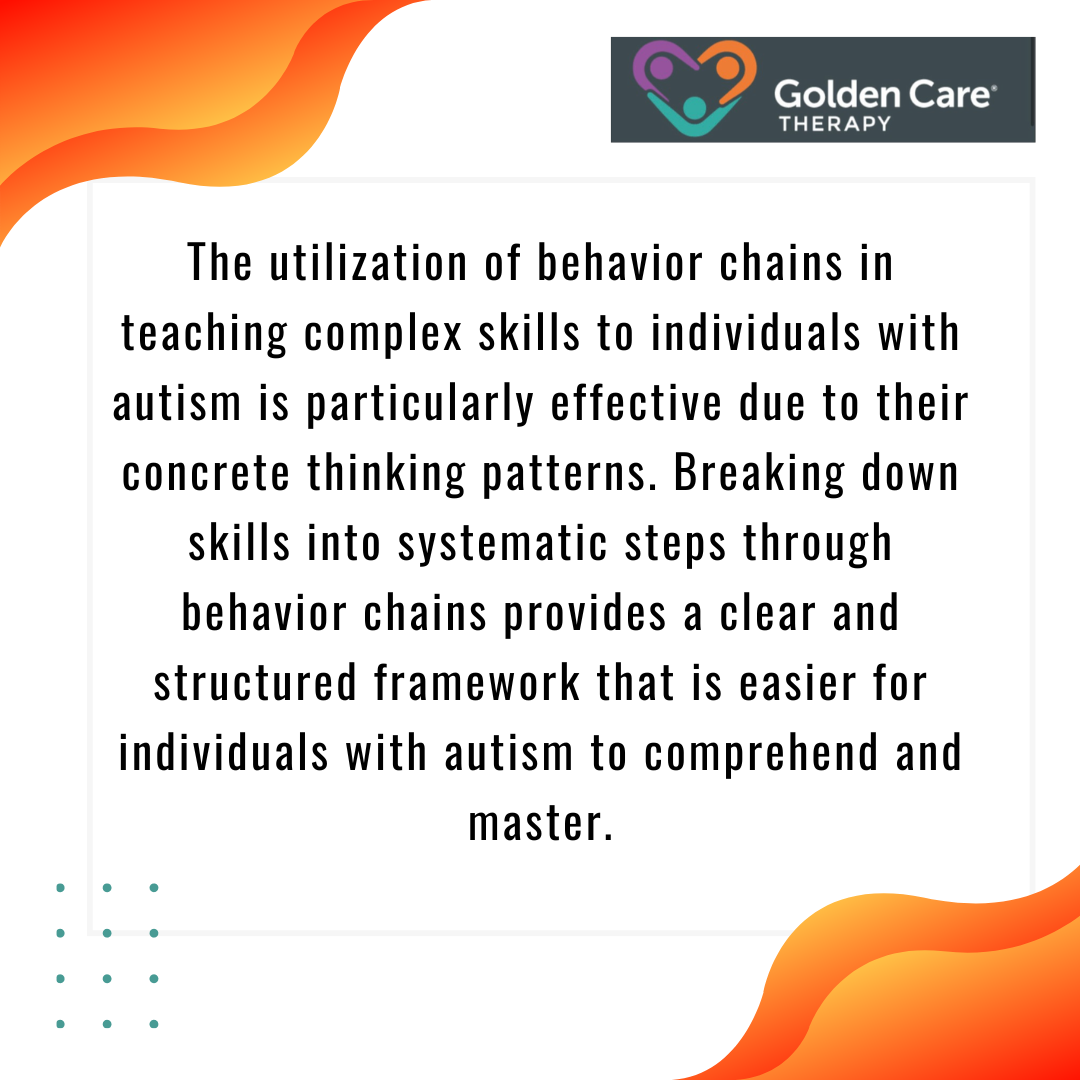
Table of Contents
ABA chaining is a powerful technique used to teach complex tasks by breaking them down into smaller, more manageable steps. Each step builds on the previous one, creating a “chain” that leads to the final goal.
This method helps individuals learn by focusing on one part of a task at a time, which can make mastering new skills easier and less overwhelming.
Chaining is especially useful for teaching everyday activities, like brushing teeth or getting dressed, where each action follows a specific sequence. Understanding how chaining works and seeing examples can provide insight into how effective this approach can be.
The Basics of Behavior Chains
Behavior chains are essentially a series of individual behaviors linked together in a specific sequence to achieve a desired outcome.
Each step in the chain serves as a cue or prompt for the subsequent step, ensuring smooth progression toward completing the overall task. By breaking down complex behaviors into smaller, more manageable components, individuals can learn and execute these behaviors more effectively.

ABA chaining involves a systematic approach to skill acquisition, starting with the creation of a task analysis to identify and organize the steps involved in the skill.
Next, individual component skills are taught separately as needed to ensure mastery. Finally, these skills are linked back together into a cohesive chain, allowing individuals to engage in complex behaviors successfully.
Types of ABA Chaining Methods
There are three main types of chaining techniques used in ABA: forward chaining, backward chaining, and total task chaining. Each approach is suited to different learners, depending on their skills, learning preferences, and specific needs.
Understanding how each method works is essential to grasp the variety of ways chaining can be applied to everyday tasks.
Forward Chaining
In forward chaining, the learner begins by completing the first step in a sequence of actions. Once the first step is mastered, the second step is introduced, and the process continues until the entire chain is learned.
For instance, if the goal is to teach someone how to make a sandwich, forward chaining might begin by teaching the individual to take out the bread. Once that is successfully mastered, the next step would be spreading butter or placing ingredients on the bread.
Gradually, the individual works their way through the steps until they can complete the entire task of making a sandwich.
The advantage of forward chaining is that it mirrors the natural order of how tasks are typically performed. The learner gains confidence by mastering each new step in sequence which helps them build competence incrementally. Each completed step leads to reinforcement, which encourages continued progress.
Backward Chaining
Backward chaining works in reverse order. The individual starts with the last step in the chain and learns to complete it independently before moving backward to the previous steps.
In backward chaining, the therapist or instructor completes all the earlier steps for the learner, and the individual is only responsible for the final action. Once they’ve mastered the last step, the therapist gradually teaches the preceding steps until the entire task can be completed independently.
The benefit of backward chaining is that it allows the learner to experience success more quickly. By completing the final step of a task, they get to see the immediate result, which can be highly motivating.
It can be particularly effective for individuals who thrive on positive reinforcement and enjoy seeing the completion of the task from the start.
Total Task Presentation
Total task chaining, sometimes referred to as “whole task” chaining, involves teaching all the steps in the chain at the same time. The individual practices the entire task from beginning to end in every session, receiving prompts and assistance as needed for any steps they struggle with.
Over time, the level of support is gradually reduced until the learner can perform the whole task independently.
This method is especially useful when a learner already has some familiarity with parts of the task or when the steps are relatively simple. Total task chaining can be efficient for tasks like setting the table, where the learner already knows how to perform individual components but needs practice in completing the entire sequence.
ABA Chaining Real-Life Examples
Chaining can be applied to teach a wide range of skills, from basic self-care routines to more complex social and academic tasks. Below are a few real-life examples of how chaining is used in ABA therapy to help individuals develop independence and functional skills.

Example 1: Brushing Teeth
Brushing teeth is a task that requires multiple steps, and chaining can break down the process to make it more accessible. In forward chaining, the individual might first be taught to pick up the toothbrush.
Once they can do this independently, the next step might be applying toothpaste. After that, they learn how to brush each quadrant of the mouth and rinse.
Finally, the last step could be putting the toothbrush away. Each step is taught sequentially, with reinforcement provided after each success.
In backward chaining, the therapist might start by completing all the earlier steps for the learner, leaving the individual to practice the final step of rinsing and putting the toothbrush away. As they master this, they work backward until they can complete the entire task.
Example 2: Handwashing
Handwashing is another critical skill that can be taught through chaining. In total task chaining, the therapist might guide the learner through the entire process of turning on the faucet, wetting hands, applying soap, scrubbing for a set amount of time, rinsing, and drying hands.
With each practice, the learner becomes more proficient, and prompts are reduced until they can wash their hands without assistance.
In forward chaining, the therapist might start by teaching the learner to turn on the faucet. Once the individual can do this independently, they move on to wetting their hands and so forth. Reinforcement is given after each new step is mastered, ensuring continued motivation.
Example 3: Social Skills
Chaining isn’t limited to physical tasks, as it can also be applied to teach social skills. For example, if the goal is to teach an individual how to greet others, the process can be broken down into smaller steps such as making eye contact, saying “hello,” shaking hands, and asking how the other person is doing.
In forward chaining, the learner might first practice making eye contact, then add the verbal greeting, and finally incorporate the handshake and conversation starter.
Social skills can often feel overwhelming to learners with autism, so breaking them down into manageable steps helps make the process less intimidating. Chaining provides a structured framework for learning and practicing these essential skills in a supportive environment.

Example 4: Academic Tasks
Chaining can also be used to teach academic skills, such as writing a complete sentence. In forward chaining, the learner might first practice writing their name. Once they can do this independently, they move on to writing a single word, then constructing a phrase, and finally writing an entire sentence.
The task is broken down into manageable parts, allowing the learner to build confidence as they progress.
In backward chaining, the instructor might help the learner write all the words of a sentence except the final word. The learner practices completing the sentence until they can do it independently. From there, they work backward to complete the entire sentence on their own.
The Key Takeaway
Incorporating ABA chaining techniques can truly unlock potential for skill development, one step at a time. By breaking down complex tasks into manageable actions, individuals can gain confidence and independence in their daily routines.
Whether it’s teaching basic self-care or more advanced skills, chaining is a powerful tool in the ABA approach that can help build meaningful progress and lasting success. Golden Care Therapy offers personalized ABA programs in New York, New Jersey, Indiana, and Georgia, to support children in achieving their full potential.
Contact us today to learn more about how our expert team can help your child succeed.
Sources:
- Video Modeling and Its Impact on ABA Learning - September 27, 2024
- Strategies for Teaching Turn-Taking in Autism - September 27, 2024
- Understanding Social Boundaries in Autism - September 27, 2024
